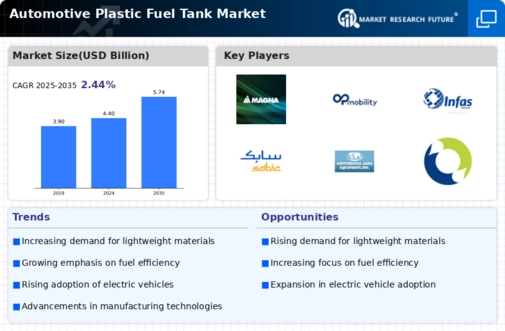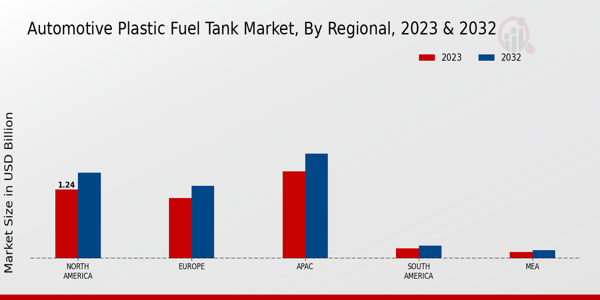Stringent Environmental Regulations
The Global Automotive Plastic Fuel Tank Market Industry is significantly influenced by stringent environmental regulations aimed at reducing vehicular emissions and promoting sustainable practices. Governments worldwide are implementing policies that encourage the use of eco-friendly materials in automotive manufacturing. Plastic fuel tanks, which can be produced with recycled materials, align with these regulatory frameworks, making them an attractive option for manufacturers. This regulatory push is likely to contribute to the market's growth, with projections indicating a rise to 5.74 USD Billion by 2035.
Increasing Vehicle Production and Sales
The Global Automotive Plastic Fuel Tank Market Industry benefits from the rising production and sales of vehicles across various regions. As global automotive production continues to expand, the demand for efficient and lightweight fuel storage solutions grows correspondingly. Emerging markets, particularly in Asia-Pacific, are witnessing a surge in vehicle ownership, further driving the need for plastic fuel tanks. This trend is expected to sustain market growth, as manufacturers seek to optimize fuel efficiency and comply with evolving consumer preferences for environmentally friendly vehicles.
Rising Demand for Lightweight Materials
The Global Automotive Plastic Fuel Tank Market Industry experiences a notable shift towards lightweight materials, driven by the automotive sector's focus on enhancing fuel efficiency and reducing emissions. Plastic fuel tanks, which are significantly lighter than their metal counterparts, contribute to overall vehicle weight reduction. This trend aligns with regulatory frameworks aimed at lowering carbon footprints, thereby fostering a more sustainable automotive landscape. As a result, the market is projected to reach 4.4 USD Billion in 2024, reflecting the growing preference for lightweight solutions in vehicle design.
Shift Towards Electric and Hybrid Vehicles
The Global Automotive Plastic Fuel Tank Market Industry is experiencing a transformative shift with the increasing adoption of electric and hybrid vehicles. While these vehicles may not require traditional fuel tanks, the demand for innovative fuel storage solutions for hybrid models remains significant. Manufacturers are exploring advanced plastic fuel tank designs that cater to the unique requirements of hybrid systems. This transition presents opportunities for growth within the market, as the automotive industry adapts to changing consumer preferences and technological advancements.
Technological Advancements in Fuel Tank Design
Innovations in fuel tank design and manufacturing processes are propelling the Global Automotive Plastic Fuel Tank Market Industry forward. Advanced technologies, such as blow molding and multi-layered tank designs, enhance the durability and safety of plastic fuel tanks. These advancements not only improve performance but also address concerns related to fuel leakage and environmental impact. As manufacturers adopt these technologies, the market is expected to witness a compound annual growth rate of 2.44% from 2025 to 2035, indicating a robust trajectory fueled by continuous innovation.


















Leave a Comment